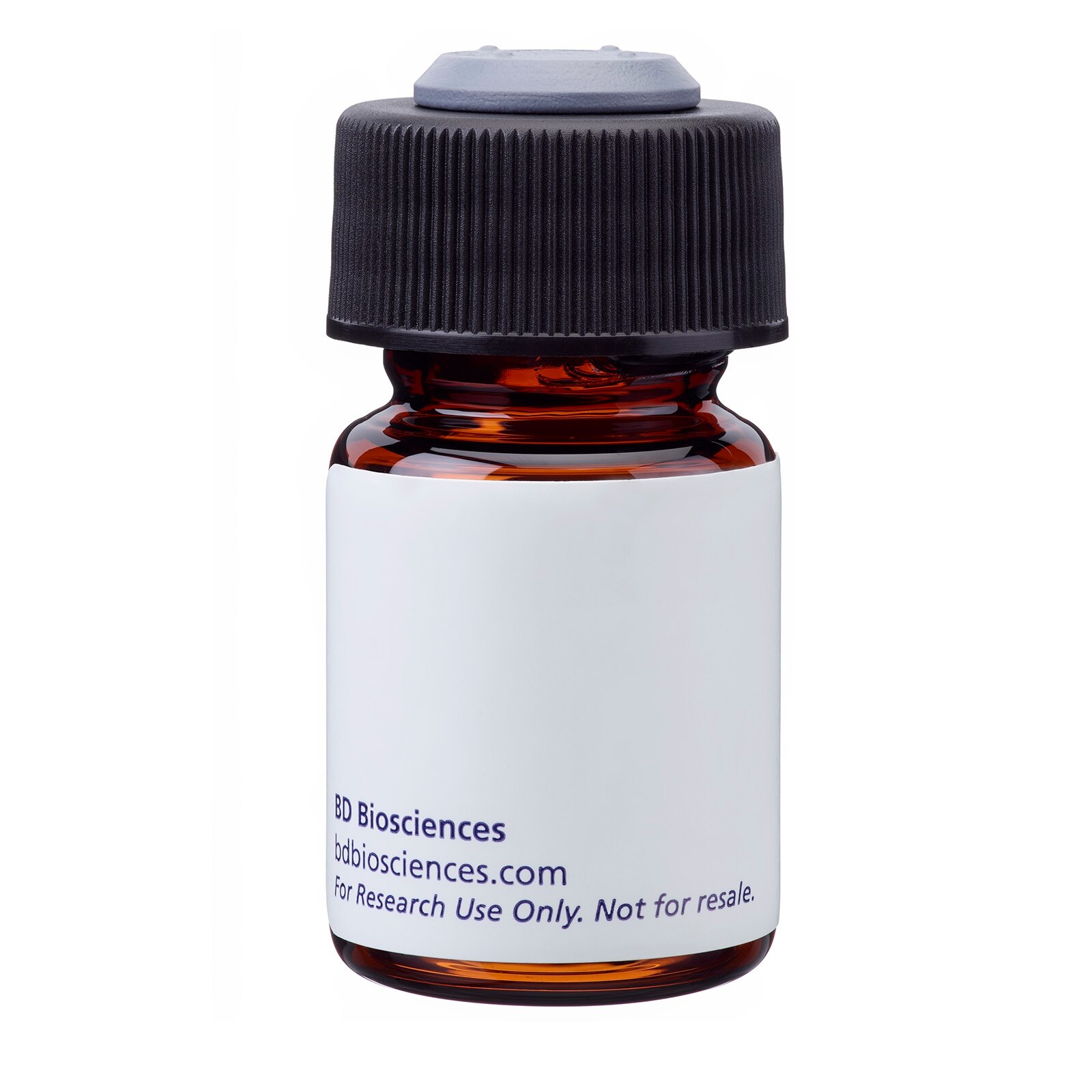Old Browser
This page has been recently translated and is available in French now.
Looks like you're visiting us from {countryName}.
Would you like to stay on the current country site or be switched to your country?






Profile of peripheral blood lymphocytes analyzed on a FACScan (BDIS, San Jose, CA)

Multiparameter flow cytometric analysis of CD99 expression on human peripheral blood leucocytes populations. Whole blood was stained with either PE Mouse IgG2a, κ Isotype Control (Cat. No. 555574; Left Plot) or PE Mouse Anti-Human CD99 antibody (Cat. No. 555689; Right Plot). Erythrocytes were lysed with BD Pharm Lyse™ Lysing Buffer (Cat. No. 555899). Bivariate pseudocolor density plots showing CD99 expression (or Ig Isotype control staining) versus side light-scatter (SSC-A) signals were derived from gated events with the forward and side light-scattering characteristics of intact leucocyte populations. Flow cytometry and data analysis were performed using a BD LSRFortessa™ Cell Analyzer System and FlowJo™ software.


BD Pharmingen™ PE Mouse Anti-Human CD99

BD Pharmingen™ PE Mouse Anti-Human CD99

Regulatory Status Legend
Any use of products other than the permitted use without the express written authorization of Becton, Dickinson and Company is strictly prohibited.
Preparation And Storage
Recommended Assay Procedures
BD® CompBeads can be used as surrogates to assess fluorescence spillover (Compensation). When fluorochrome conjugated antibodies are bound to BD® CompBeads, they have spectral properties very similar to cells. However, for some fluorochromes there can be small differences in spectral emissions compared to cells, resulting in spillover values that differ when compared to biological controls. It is strongly recommended that when using a reagent for the first time, users compare the spillover on cells and BD® CompBeads to ensure that BD® CompBeads are appropriate for your specific cellular application.
Product Notices
- This reagent has been pre-diluted for use at the recommended Volume per Test. We typically use 1 × 10^6 cells in a 100-µl experimental sample (a test).
- An isotype control should be used at the same concentration as the antibody of interest.
- Caution: Sodium azide yields highly toxic hydrazoic acid under acidic conditions. Dilute azide compounds in running water before discarding to avoid accumulation of potentially explosive deposits in plumbing.
- Source of all serum proteins is from USDA inspected abattoirs located in the United States.
- Please refer to www.bdbiosciences.com/us/s/resources for technical protocols.
- For fluorochrome spectra and suitable instrument settings, please refer to our Multicolor Flow Cytometry web page at www.bdbiosciences.com/colors.
- Please refer to http://regdocs.bd.com to access safety data sheets (SDS).
The TÜ12 monoclonal antibody specifically recognizes CD99, also referred to as E2 antigen, a 32 kDa sialoglycoprotein expressed on all leucocyte lineages. The E2 antigen is the MIC2 gene product and is differentially expressed during T- and B-lymphoid and granulocytic development, with higher densities being expressed during early hematopoietic stages. Mature granulocytes express very little or no CD99. E2 has been shown to be involved in T-cell adhesion processes and is suggested to have a functional role in hematopoietic adhesion pathways.
This antibody is routinely tested by flow cytometric analysis. Other applications were tested at BD Biosciences Pharmingen during antibody development only or reported in the literature.

Development References (6)
-
Aussel C, Bernard G, Breittmayer JP, Pelassy C, Zoccola D, Bernard A. Monoclonal antibodies directed against the E2 protein (MIC2 gene product) induce exposure of phosphatidylserine at the thymocyte cell surface. Biochemistry. 1993; 32(38):10096-10101. (Biology). View Reference
-
Chang A, Benda PM, Wood BL, Kussick SJ. Lineage-specific identification of nonhematopoietic neoplasms by flow cytometry.. Am J Clin Pathol. 2003; 119(5):643-55. (Clone-specific: Flow cytometry). View Reference
-
Dworzak MN, Fritsch G, Buchinger P, et al. Flow cytometric assessment of human MIC2 expression in bone marrow, thymus, and peripheral blood. Blood. 1994; 83(2):415-425. (Biology). View Reference
-
Gelin C, Aubrit F, Phalipon A, et al. The E2 antigen, a 32 kd glycoprotein involved in T-cell adhesion processes, is the MIC2 gene product. EMBO J. 1989; 8(11):3253-3259. (Biology). View Reference
-
Knapp W. W. Knapp .. et al., ed. Leucocyte typing IV : white cell differentiation antigens. Oxford New York: Oxford University Press; 1989:1-1182.
-
Uchańska-Ziegler B, Wernet P, Ziegler A. Differentiation of a human myeloid cell line (HL-60) toward granulocyte- and macrophage-like cells: comparison of cell surface antigen expression.. Haematol Blood Transfus. 1983; 28:386-8. (Clone-specific: Immunofluorescence). View Reference
Please refer to Support Documents for Quality Certificates
Global - Refer to manufacturer's instructions for use and related User Manuals and Technical data sheets before using this products as described
Comparisons, where applicable, are made against older BD Technology, manual methods or are general performance claims. Comparisons are not made against non-BD technologies, unless otherwise noted.
For Research Use Only. Not for use in diagnostic or therapeutic procedures.
Report a Site Issue
This form is intended to help us improve our website experience. For other support, please visit our Contact Us page.
